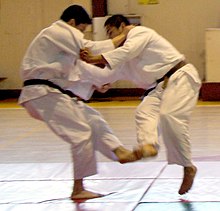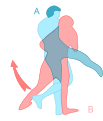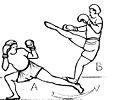Sweep (martial arts)
In martial arts, a sweep refers to a change in position that occurs when the opponent is levered out. Nevertheless, it is not to be confused with a transition in which one's own position is changed, but the opponent remains in his starting position, and a takedown , which describes a "bringing down" from a standing position.
Generally there are two categories of sweeps: standing and on the ground.
In the state
A takedown can take place by means of a sweep, but does not have to be, so that takedowns cannot generally be referred to as sweeps, but sweeps from a standing position as takedowns.
The general feature of all sweeps is that they can be performed with little effort by using the physical leverage . To do this, they usually start with the legs. Other ways of performing a takedown would be, for example, by throwing the shoulder (e.g. in judo ) or by forcing the opponent to the ground, e.g. using one's own body weight (e.g. clinch ).
The physical force of the sweep can on the one hand be perpendicular to the opponent's leg, so that the leg is raised and thus the opponent's friction on the ground is reduced. An example of this is the double leg takedown , in which the shoulder is pressed into the opponent's hips in order to lift him up and the legs are blocked at the same time.
The other variant is to use the force horizontally in order to disturb the stability, for example with the ankle pick , in which the ankles of the opponent are blocked and the opponent is brought down by pushing horizontally. This principle can also be found in the leg sweeper , which is used, for example, in kickboxing or kung fu .
In Japan the leg sweep is known as ashi-barai .
Illustration kickboxing
Using a hook kick
Using a spinning kick
On the ground
On the ground, as mentioned above, a sweep is a technique used to move from a neutral or negative position to a better one.
Examples:
- From the guard to the mount
- As an "Escape" from the mount, by blocking the arms and feet of the opponent sitting on top and turning the opponent; after that the fighter is still in the guard; however, this is a better position than being checked from the mount on the ground.
- From the side control to liberation.
Push sweep
A push sweep is one of the techniques described in the book Brazilian Jiu-Jitsu, Theory and Technique by Renzo Gracie and Royler Gracie . It is also featured in Grandmaster Kyuzo Mifune's judo video documentary The Essence of Judo , and it is an unnamed technique in the standard work The Canon Of Judo . The main feature of the push sweep is that the performers do not roll the opponent sideways or over the shoulder, but rather, while they are on the floor, slide between the legs of the standing opponent and block his knee. The push sweep is often used as a follow-up technique to an open guard .
Differentiation from the transition
A sweep must not be confused with a transition.
A transition is a transition from one position to another. In contrast to the sweep, the opponent is not moved, but you move yourself from one position to another. This can be done, for example, from the mount to the back or from an armbar to a triangle .
This plays a central role in grappling, as "freezing" (stalling) on the one hand costs strength and in tournament combat often also costs points.
On the other hand, in contrast to "hitting" martial arts, where an evasive distance is often sought, when grappling the goal is to seek the proximity of the opponent and to remain "connected". Only in exceptional cases do you tear yourself away from your opponent and start again.
If a sweep cannot be achieved, for example because the opponent is defending his balance too well, a transition is often the better choice in order to take a more favorable position.
Good grapplers can move so skillfully and quickly that the opponent becomes confused and can no longer keep up with the pace in his defense.
In judo, the term is also used for an elegant transition between standing and ground fighting.
See also
- Throwing technique (judo)
- Aikido techniques
- Nage-Waza (Yuishinkan)
- Throwing technique (martial arts)
- Takedown (martial arts)
Individual evidence
- ↑ Sweeps in the state, accessed on December 29, 2017 ( Memento of the original from July 31, 2017 in the Internet Archive ) Info: The archive link was automatically inserted and not yet checked. Please check the original and archive link according to the instructions and then remove this notice.
- ↑ Sweeps on the floor, accessed December 29, 2017
- ↑ International Brazilian jiu-jitsu Federation (IBJJF) set of rules, accessed on December 29, 2017
- ^ Wrestling; How to do a Basic ankle pick, accessed December 29, 2017
- ↑ Foot sweep while kickboxing at www.kickboxxen.de, accessed on December 29, 2017
- ↑ Basics of Kung Fu including foot sweep, accessed on December 29, 2017 ( page no longer available , search in web archives ) Info: The link was automatically marked as defective. Please check the link according to the instructions and then remove this notice.
- ↑ Der Beinfeger on judoonline.de, accessed on December 29, 2017 ( Memento of the original from July 19, 2017 in the Internet Archive ) Info: The archive link was inserted automatically and has not yet been checked. Please check the original and archive link according to the instructions and then remove this notice.
- ^ Renzo Gracie and Royler Gracie. Brazilian Jiu-Jitsu, Theory and Technique. Invisible Cities, 2001. ISBN 1-931229-08-2 .
- ↑ The Essence Of Judo, video documentation by Judo Grandmaster Kyuzu Mifune, Youtube, as of: December 29, 2017
- ↑ Kyuzo Mifune. The Canon Of Judo. Kodansha International, 2004. ISBN 4-7700-2979-9 .
- ↑ Article "Grappling Facts and Fiction" on the Lawrence Eng transition , accessed on April 3, 2018.
- ↑ NAGA 2018 regulations on Stalling, page 21, 55 ff. , Accessed on April 3, 2018.
- ↑ IBJJF rules on Stalling, pages 8, 23, 28 , accessed on April 3, 2018.





